The 9.7" iPad Pro Review
by Brandon Chester on June 1, 2016 9:00 AM ESTSystem Performance
Like the larger iPad Pro, the 9.7" iPad Pro uses Apple's A9X SoC. Apple is never very forthcoming with details like the clock speed for the CPU, GPU, and amount of DRAM. What we can determine about the SoC is that Apple has maintained the 2.2GHz maximum clock speed from the larger iPad Pro, while reducing clocks on the GPU and dropping to 2GB of LPDDR4 RAM.
The RAM situation on the 9.7" iPad Pro is somewhat surprising for a few different reasons. In their always-excellent teardown, the iFixit crew discovered that the smaller iPad Pro only had one Samsung 2GB LPDDR4 memory chip. This explains how Apple scaled down from 4GB to 2GB - the larger iPad Pro had two chips - but it also means that Apple has changed the amount of memory bandwidth available to the A9X SoC as well.
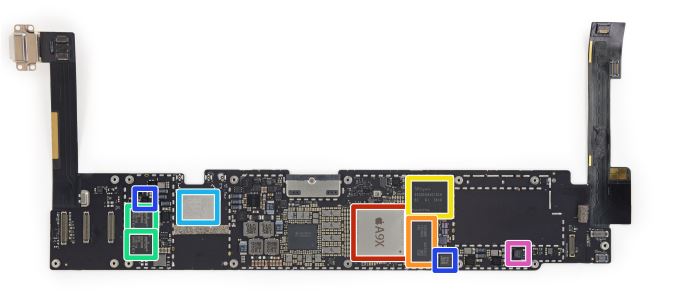
9.7" iPad Pro Logic Board (Image Courtesy iFixit)
To date, all Apple X-series SoCs have shipped with a larger 128-bit memory bus, and until now, Apple always fully populated that bus. So the 9.7" iPad Pro is an outlier in that regard, as this is the first time we've seen an X-series SoC with only the first 64-bit half wired up to a single memory chip in this fashion. In that respect it's a surprising decision from Apple, in part because of the importance of memory bandwidth in feeding the large, powerful GPUs on the X-series SoCs.
Consequently there is going to be more to the 9.7" iPad Pro than just the original Pro in a smaller chassis. The 9.7" iPad Pro should match the larger model in anything that depends heavily on CPU speed or memory bandwidth, while falling behind to some degree in GPU-bound tests. The 12 cluster PowerVR Series7XT GPU inside A9X will be having to make do with less memory bandwidth, though offset to some degree by the lower resolution of the screen.
With the above in mind, I quickly benchmarked the 9.7" iPad Pro on a couple of our memory bandwidth benchmarks. The results are somewhat inconclusive.
| Geekbench 3 Memory Bandwidth Comparison (1 thread) | ||||||
| Stream Copy | Stream Scale | Stream Add | Stream Triad | |||
| 9.7" iPad Pro | 17.1 GB/s | 11.5 GB/s | 12.9 GB/s | 12.8 GB/s | ||
| 12.9" iPad Pro | 20.8 GB/s | 15.0 GB/s | 15.3 GB/s | 15.1 GB/s | ||
I say "inconclusive" because although the 9.7" iPad Pro consistenly scores lower in Geekbench 3's memory bandwidth benchmarks and other memory benchmarks, it's never a 50% drop as we get on paper. In practice these numbers are far from the maximum memory bandwidth A9X is capable of, and I suspect that the CPU paths simply aren't wired in such a fashion that they can fully saturate A9X, especially given the fact that it's the GPU that needs the bandwidth more. So although we see some impact of the narrower memory bus in dedicated memory bandwidth benchmarks, these can't paint a very clear picture. It's going to be our high level GPU performance benchmarks that really give us an idea of the impact of reduced memory bandwidth.
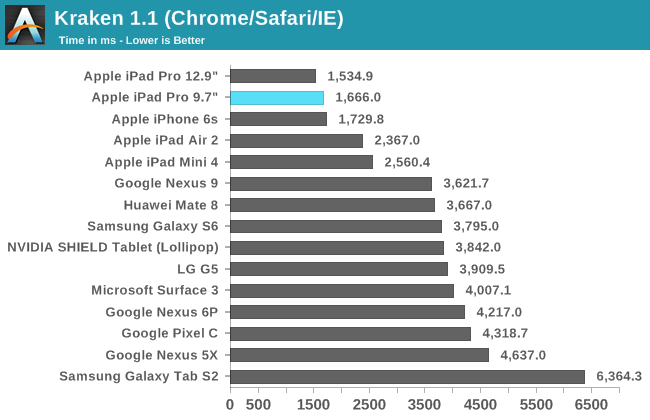
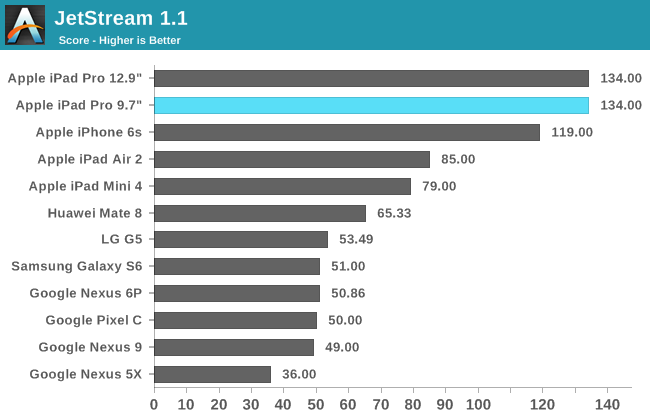
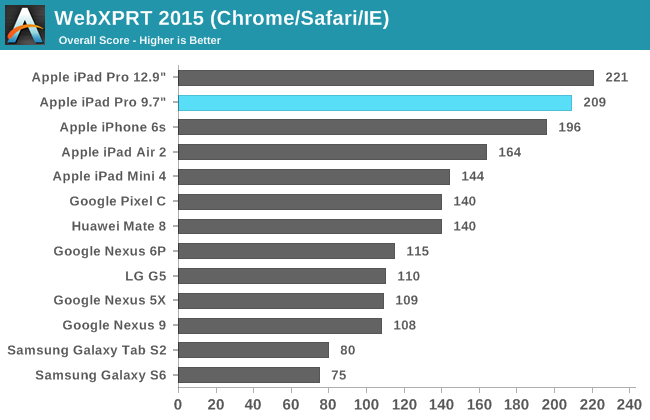
With the 9.7" iPad Pro having the same two 2.2GHz Apple Twister cores as the 12.9" model, it's no surprise to see the two neck and neck in our browser tests. In Jetstream 1.1 the two achieve the exact same score, while in the other two tests the 9.7" model is a bit slower, but with the gap being small enough to attribute to testing variance. With A9X Apple moved back to a dual-core CPU from A8X's tri-core CPU, with the move to TSMC's 16nm FinFET process allowing peak clock speeds to go up by 700MHz. Because JavaScript performance is mostly bound by a device's single threaded performance, A9X came with a significant performance uplift during web browsing. Given that the 12.9" iPad Pro offered the best web browsing performance of a mobile device, bringing that performance to the 9.7" iPad makes for a notable improvement over the performance of the iPad Air 2.
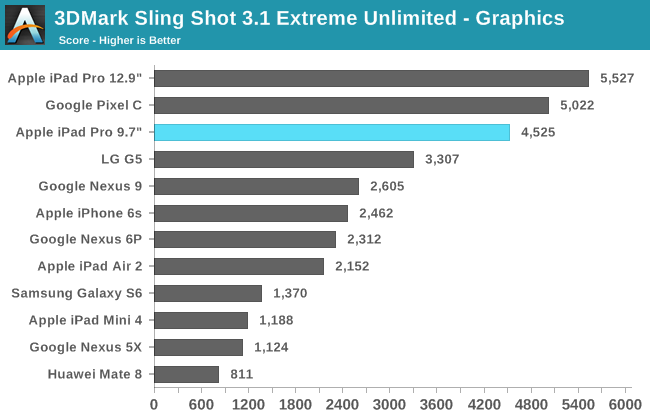
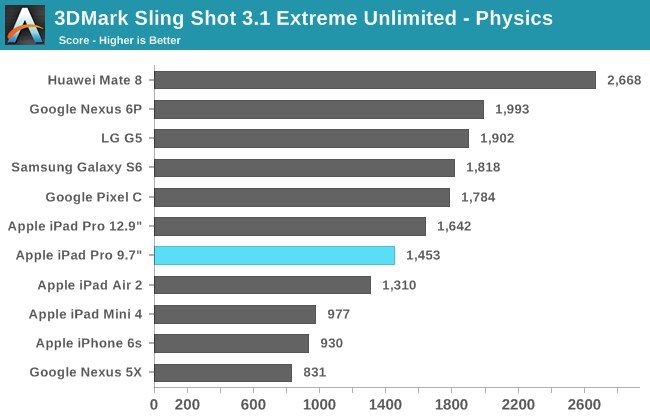

The 9.7" iPad Pro does well in 3DMark's graphics test, but like Ice Storm it doesn't do well in the physics test. It seems that this test is programmed in a similar way to Ice Storm, and in that sense I'm not sure how representative the physics test is of real-world performance because with an actual mobile game you wouldn't use highly random memory access and data structures with heavy memory dependencies when it would perform very poorly on your target devices. In any case, you can see that the 9.7" iPad Pro places third overall, with the 12.9" model at the top of the chart and the Pixel C coming right behind it.
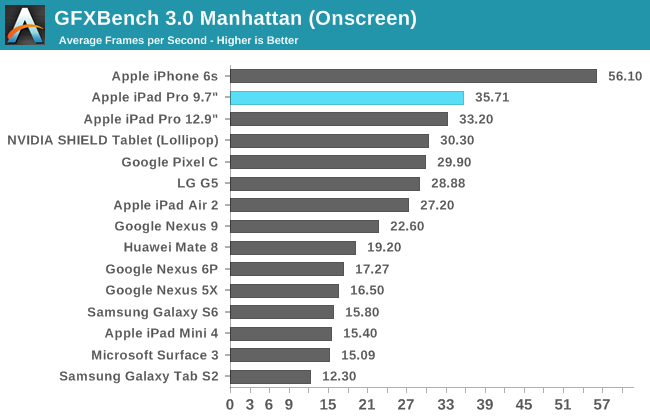
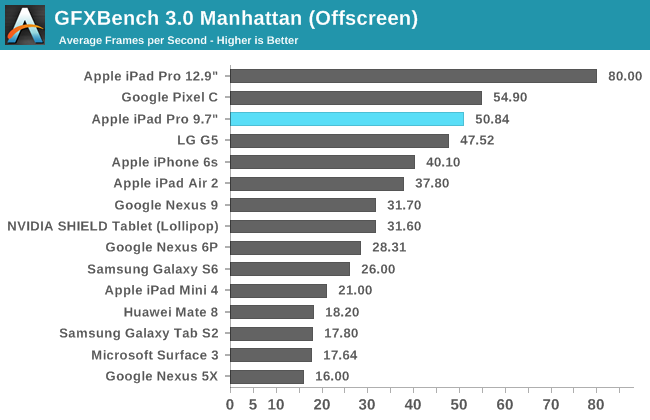
GFXBench 4.0 Car Chase hasn't made its way to iOS yet, and so for now we're still using GFXBench 3.0 Manhattan for iOS devices. Given that the iPhone 6s is the only phone that hits Vsync in this test, it's still a very relevant benchmark in how it represents the level of visual fidelity that a mobile game can currently have on high end devices while still performing well. In the off screen test we can see the impact of the 9.7" iPad Pro's lower clocked GPU combined with the reduced memory bandwidth,, with the smaller iPad performing around 37% lower than that of the 12.9" iPad Pro. The on screen test tells an interesting story though. Both models of the iPad Pro have roughly the same performance at their native resolutions in this test, which could indicate that Apple was targeting the same performance relative to the display resolution when configuring A9X and its memory, in order to manage heat and energy usage in a smaller iPad Pro.
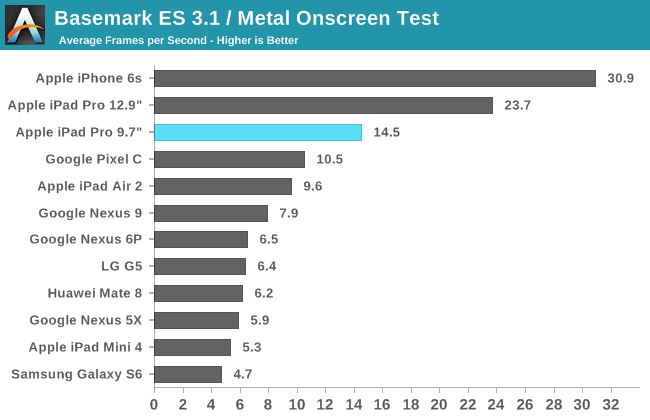
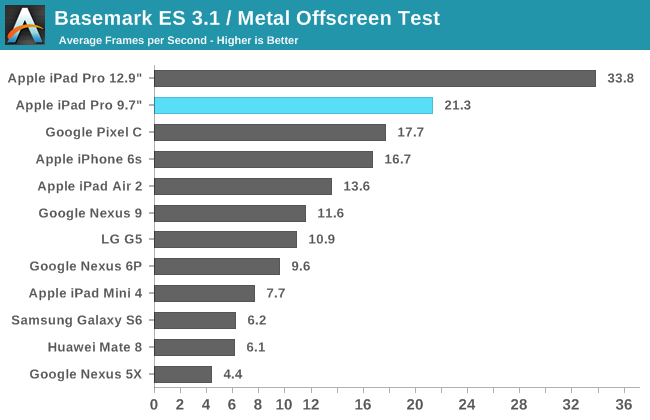
While I didn't have enough data to use BaseMark ES 3.1 at the time of my iPhone SE review, we've since tested enough older devices to deploy it. One could think of this as the successor to BaseMark X, which we retired some time ago before we officially deployed a new mobile test suite for 2016. Once again, both models of the iPad Pro sit above the other tablets on the chart. The iPhone 6s places first in the on screen test due to its relatively low resolution, but without that there the iPads would hold the top two spots in both tests.
NAND Performance
Something that Apple publicized with their A9 and A9X SoCs is improved NAND performance. NAND performance isn't discussed very much in reviews, but it's a very critical aspect of device performance and issues with it tend to cause a device's performance to crash months down the line rather than right off the bat, which makes it something of an invisible problem if you don't look for it during a review. We've seen previously that Apple has been using their own SSD controller in the current generation of iOS devices, and the 9.7" iPad Pro continues this.
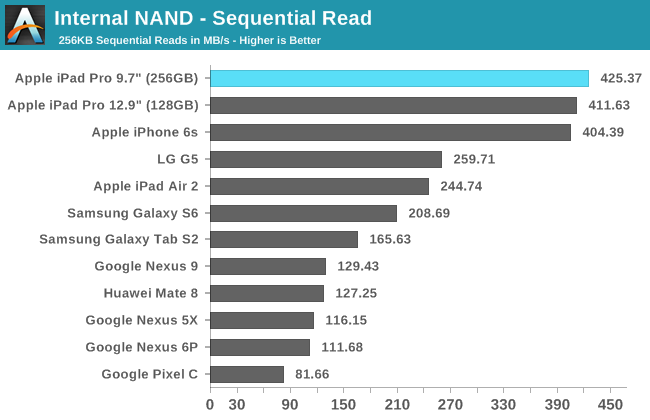
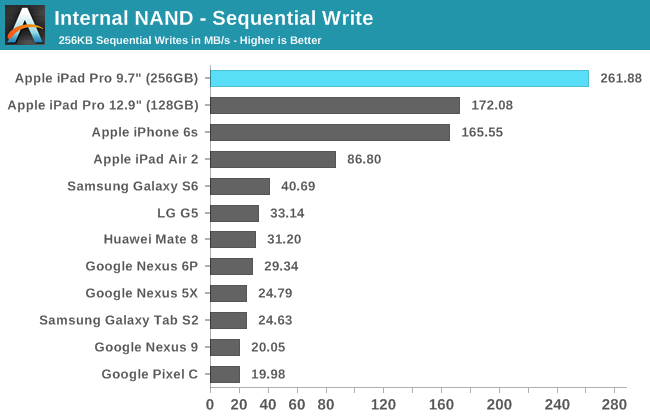
For this review I was sampled the 256GB model of the 9.7" iPad Pro. Because SSDs exploit parallelism heavily to improve performance, a 256GB iPad could improve NAND write performance over the lower-capacity models if it has a greater number of dies. In this case we see that sequential read performance improves a bit, while sequential writes improve dramatically as expected. There's not a lot to say here, as Apple has an enormous lead over the competition in this area.










144 Comments
View All Comments
The Garden Variety - Wednesday, June 1, 2016 - link
For the love of god: Stop it. Stop putting spaces between the end of your sentence or clause and your punctuation. I realize the French in particular insist on doing this because, well, they're French, but that doesn't change the fact that for written English it is completely and entirely wrong. If you want to be taken seriously, be serious. Write like you care, not like a third grader. English not your first language? Fair enough, but then consider this your first step toward being taken more seriously in your communication.Brandon Chester - Wednesday, June 1, 2016 - link
The question mark with spaces on both sides reminds me of the conditional operator in C :)kurahk7 - Wednesday, June 1, 2016 - link
Keep in mind that each of these publications only have a sample size of one, and that there are variances between the same products. Because of that, Displaymate might have received an iPad with a slightly worse calibration/panel than Anandtech and vice versa for the Surface.BadSimian - Wednesday, June 1, 2016 - link
Displaymate on the iPad Pro's screen - "It is by far the best performing mobile LCD display that we have ever tested, and it breaks many display performance records." http://www.displaymate.com/iPad_Pro9_ShootOut_1.ht...Deelron - Wednesday, June 1, 2016 - link
"Since departure of Anand, Apple product reviews look like PR marketing speech, although the tests and content itself of the review do not match the speech"Amusing since so many reviews by Anand on Apple products had the exact same refrain in the comments.
Wolfpup - Wednesday, June 1, 2016 - link
Huh? Apple's CPUs have been years ahead of the ARM stuff available for Android for...years. Swift was a nice A9+ just like Krait, but since the year after (2012) their CPUs have just been massively far ahead...and yet I STILL hear comments like this that seem completely unaware of that.zepi - Wednesday, June 1, 2016 - link
Amoled doesn't mean infinite contrast in practice, only in pitch black test environment. In real life blackest signal is (reflectance) x (ambient light), not zero. Due to this, in high ambient light new iPad has better blacks than any amoled display on the market.And actually, if we go to signal processing maths and measurements, we could start drawing comparisons from them. No one in their right mind would try to argue that 16-bit CD quality audio has infinite dynamic range, even though it is very easy to sample total silence in form of zero signal value to a musical track.
Also music volume is not considered to be infinite, but the value is compared to arbitrarily defined human hearing threshold and converted to logarithmic decibels with 0 meaning non-zero value at the lowest level human ear can measure.
One pretty reasonable comparison point for amoled contrast might be using the quantization error at lower end of the brightness. Ie: something along the lines of set brightness of display to max, display uniform pictures of gray at RGB(1,1,1), measure this brightness in lumens, divide by two (this is quantization error for lowest measurable signal) and then use this as a divisor for the highest recorded value for RGB(255,255,255). Depending on gamma, dividing by two gives wrong results, but for linear display this would be ok.
Infinitely linear displays are available ACME shop just next to frictionless bearings and other such very handy things...
UtilityMax - Monday, June 6, 2016 - link
I suspect iPad Pro is compared with the flagship android smartphones because Android tablet hardware sucks. Just have a look at the Galaxy Tab S2 or the Pixel C.tecsi - Wednesday, June 1, 2016 - link
Any chance of including iPad Air benchmark numbers as many of we iPad Air owners want to understand the performance gains we can expect.I assumed I could just look at your iPad Air 2/iPad Air reviews to get those numbers there, but apparently your benchmarks are different as the iPad Air 2 Kraken 1.1 numbers were different in the two reviews.
Please let us know if you can do this.
Ryan Smith - Wednesday, June 1, 2016 - link
Unfortunately we do not have the original Air, so we are unable to generate any new numbers for it.